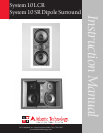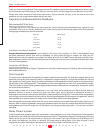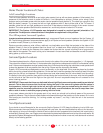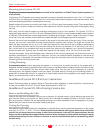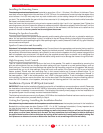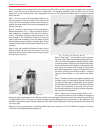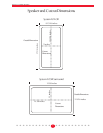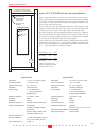
System 10 InWall Speakers
● ● ● ● ● ● ● ● ● ● ●
4
● ● ● ● ● ● ● ● ● ● ●
Mounting Issues System 10 LCR
We always recommend a professional be involved in the installation of InWall Theater System speakers, if
at all possible.
The System 10 LCR speaker can be easily mounted in most any standard wall material, from 1/2 to 1 1/2 inches (12
to 38 mm) thick. Its rotating wall clamps firmly fix it to the wall surface after the proper cutout has been made. Here
are some important precautions to take before mounting:
Keep the sides of the actual mounting hole at least 1 inch (25 mm) away from beams or studs. The clamps require
3/4 of an inch (19 mm) to rotate, and a stud or other obstruction that’s too close will stop them from properly doing
their job.
Wall cavity size will effect the bass and midrange performance of any in-wall speaker. The System 10 LCR is
designed to play optimally in a 0.5 to 1.25 cubic foot space (864 to 2160 cu. inches, measured before wall insulation
is inserted). Cubic dimensions can be determined by multiplying the length x width x height of the cavity. A larger
cavity won’t hurt, but a smaller one will definitely impact the bass and midrange response of the system.
Some of the sound from the speaker will transmit to the space on the other side of the wall cavity. If this is a major
concern, you can build a box within the wall that provides the required cubic volume. The larger the volume, the
better the bass response will be, up to 1.25 cubic feet. Beyond this size there will be no effective performance
gain. Also please note that there is very little room behind the drivers in a standard “2 x 4” wall cavity (1/4 inch, 6
mm), so the back of any enclosure box must be made from relatively thin materials, yet it should not physically
contact the back wall. Typically then, the back wall material will be roughly 1/8 to 1/4 inch (3 to 6 mm) thick.
Insulate the speaker cavity with fiberglass wool, observing all the relevant precautions and instructions from the
insulation manufacturer. If you have built a back box, you can use common fiberfill (available at craft stores as
pillow stuffing), or fiberglass in the enclosure. Be sure to push the insulation back from the drivers to ensure that
it doesn’t get into the moving cone area.
Ceiling Mounting
It is especially important when mounting the speaker in a ceiling that you cover the back of the system with a
fiberglass window screening (available at any home center or hardware store) to keep insulation and other foreign
matter out of the assembly. You also should install safety wires from the rear of the assembly to a secure
mounting place, like adjacent beams or the floor above, for added security. Should you be installing System 10
speakers in a suspended ceiling, it is imperative to install safety wires from the speaker to the support structure
above, to ensure security under all conditions.
Installation of System 10 LCR in New Construction
Atlantic Technology offers an optional Rough-in Frame Kit to ease installation in new construction. Instructions for
its use are included with this kit. The kit’s model nomenclature is IN-NC-10
Installation of System 10 LCR in Existing Construction
Remove and Installing the Grille
Remove the grille from the speaker using an awl or the point of a drywall screw in a grille opening near one of the
grille corners. Slowly pry the grille out, being careful not to damage the speaker’s frame or its finish. Install the
grille by pressing it carefully into the appropriate opening in the frame assembly. Since it’s designed to fit snugly,
please take your time and use care when installing the grille.
Cutting the Opening
After determining the best location for the speaker as outlined above, use the enclosed template to cut the proper
size hole (15 13/16” x 7”, 402 x 178 mm). Exercise extreme care before making any wall cuts to ensure that
you will not cut through any wires, pipes, or other items that may be in the wall. You may sometimes, but not
always, be able to determine the approximate location of wires and pipes by looking at the locations of nearby
outlets and plumbing. But their location or absence is never an assurance that there is not something within
the wall cavity.



